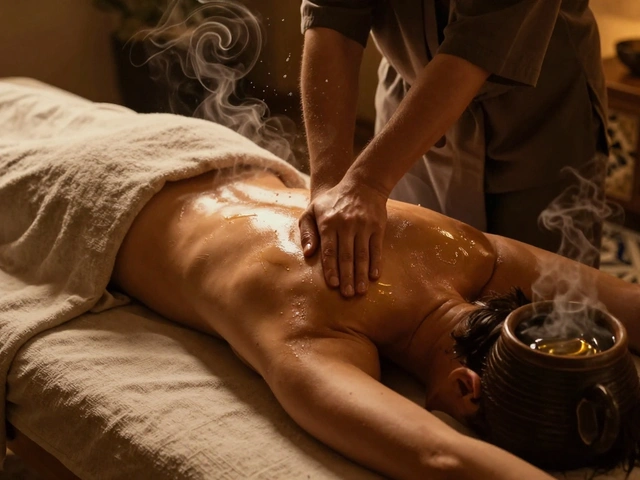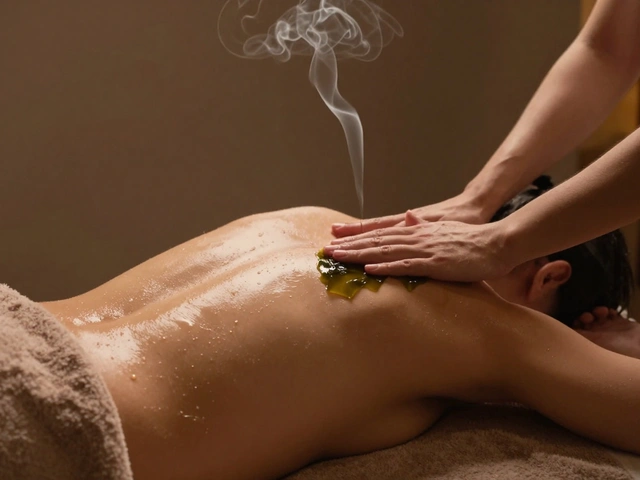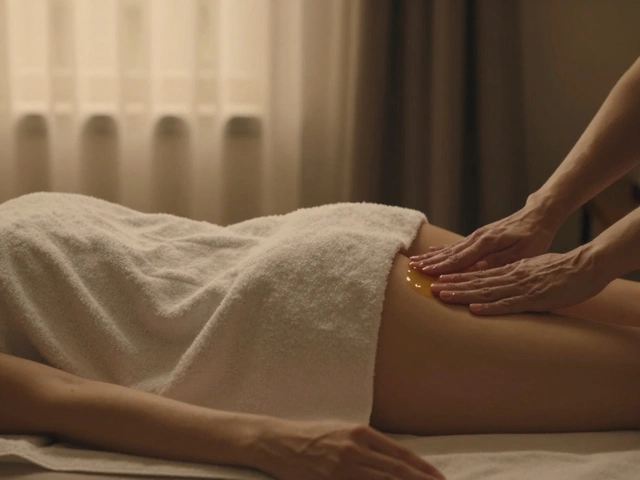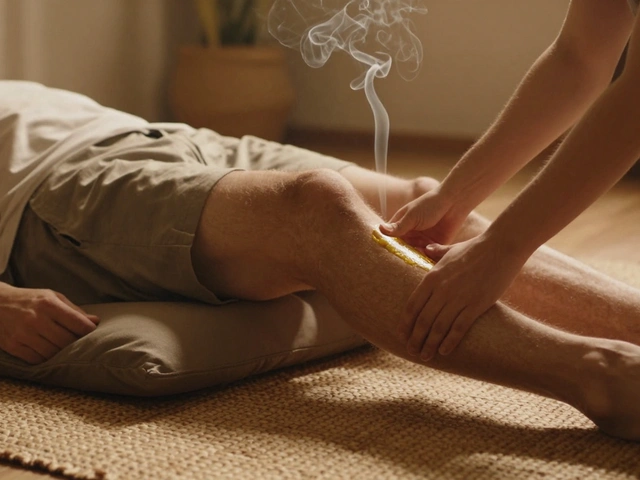Ever drag yourself out of bed and feel tired even after a full night's sleep? You’re not alone—energy slumps seem to hit at the worst times. Believe it or not, body massage can help flip that switch and get your spark back.
Here’s something cool: when you get a massage, it’s not just about relaxing. The kneading, rolling, and even gentle pressing help boost blood flow and kickstart your nervous system. That means more oxygen, less stress, and—best of all—way more energy. Sounds better than your third cup of coffee, right?
If you’ve ever walked out of a massage studio feeling lighter or more awake, that wasn’t just in your head. Studies have shown massage can reduce fatigue and make you more alert. It’s like a mini reset for your whole body, and you don’t need to be a pro athlete to feel the difference.
So, if you’re tired of feeling tired, keep reading to find out how massage jumpstarts your energy and how to choose the type that actually works for everyday people like us.
- Why Massage Works for Low Energy
- Choosing the Right Massage for an Energy Boost
- What Happens During Your Massage Session
- Tips for Making the Most of Your Massage
Why Massage Works for Low Energy
Feeling drained isn’t just about not getting enough sleep. Stress, muscle tension, and sitting all day mess with your body’s natural energy. Turns out, body massage can help untangle that whole mess. The big reason? Massage improves circulation, which means your blood moves faster and gets more oxygen around your body. It’s like kickstarting your internal engine.
When a massage therapist presses and kneads your muscles, your body responds by cranking out more endorphins and reducing levels of cortisol—the stress hormone. Higher endorphins mean you feel happier and more awake. Lower cortisol helps cut that brain fog and constantly tired feeling that kills motivation.
Let’s break it down with some simple science. Research from the Touch Research Institute at the University of Miami found that people who got a 20-minute chair massage at work reported feeling more focused and less tired, with measurable drops in anxiety and blood pressure. Their results weren’t just a fluke, either—multiple studies confirm that even short massages can make you feel peppier.
Check out how massage sets things in motion:
- It gets your blood and lymph moving, which helps your muscles recover and flushes out toxins.
- Your muscles relax, making it way easier to breathe deeply (hello, more oxygen!).
- It signals your brain to shift from "fight or flight" to "rest and digest," so you genuinely chill out.
- Quality sleep often follows, which is a huge win for all-day energy.
| Massage Effect | Benefit for Energy |
|---|---|
| Increased Circulation | Faster delivery of nutrients and oxygen |
| Lower Cortisol | Less stress, better mental clarity |
| Muscle Relaxation | Less fatigue and soreness |
| Boosted Endorphins | Elevated mood and focus |
So, next time you’re wiped out, skipping another cup of coffee and booking a massage therapy session could be the smarter move for real, lasting energy.
Choosing the Right Massage for an Energy Boost
To really get that energy boost from a body massage, picking the right type is key. Not every massage is built the same. Some leave you zonked, others get you up and moving like you just had an espresso shot—without the jitters. Here’s how to tell the difference.
Swedish massage is the classic “feel good, wake up” style. It uses steady strokes and some kneading, which ramp up your blood flow and keep your circulation on point. This is a safe bet if you want to leave feeling refreshed, not sleepy.
If you want something a little deeper, sports massage and deep tissue massage are both solid energy-boosters. They use stronger pressure and target knots that slow you down. These styles are perfect right after a tough workout, or if sitting at your desk all day leaves your muscles feeling dead.
Looking for something different? Thai massage mixes stretches with massage, leaving you more limber and alert. Some people call it “lazy yoga,” but don’t let that fool you—it can wake up muscles you forgot you had. Another favorite is shiatsu, a Japanese method using finger pressure on key energy points, which can snap you out of an energy slump fast.
Quick comparison? Check this table for a direct look at what each common massage style does for your energy levels:
| Massage Type | How It Helps Energy | Best For |
|---|---|---|
| Swedish | Boosts blood flow, light muscle relief | First-timers, low to moderate fatigue |
| Sports/Deep Tissue | Releases muscle tension, resets body | Athletes, sore bodies |
| Thai | Improves flexibility, energizes | Tight muscles, anyone liking some stretch |
| Shiatsu | Targets energy points, balances flow | Chronic fatigue, stress relief |
If you’re not sure what to pick, don’t stress. Tell your massage therapist you want a body massage that will boost your energy levels. They can mix things up and focus on the parts that need the most wake-up call.
One underrated tip: Book your massage earlier in the day. Massages that energize work best when you can put that new spark to good use instead of heading straight to bed right after. And stay hydrated; water helps your body clear out the gunk released during your session.

What Happens During Your Massage Session
Walking into your first body massage session can be a little nerve-wracking if you don’t know what to expect. The good news is, it’s not complicated. Here’s a straight rundown of what usually happens, from start to finish—and why each step actually helps with your energy levels.
First up, your therapist asks a couple of quick questions about your daily habits, work stress, and any muscle soreness. This isn’t just small talk. Tailoring the session helps target your trouble spots and gets results.
Next, you get shown where to change and how to get set up on the table. Most places use warm towels, dim lighting, and chill music to get you into the relaxation zone fast. You’ll usually start face-down, but the therapist will let you know if they want you to flip over for certain muscles.
- The therapist starts with light, broad strokes. This warms up your muscles and gets the blood flowing.
- With your muscles loosened up, they move into deeper movements. Expect kneading, circular pressures, or tapping motions. Science backs this up: these actions send more oxygen-rich blood pumping through your body, which cranks up your energy afterwards.
- Most therapists check in about pressure. Don’t be shy—let them know what feels good and what’s too much.
When it comes to pure facts, research published in the Journal of Alternative and Complementary Medicine found that people who received a standard 45-minute Swedish massage reported feeling much less fatigue—and their blood pressure and heart rate dropped, too.
| Massage Step | Purpose |
|---|---|
| Light Strokes | Warm up muscles, increase comfort |
| Deep Pressure & Kneading | Boost circulation, reduce muscle tension |
| Stretching & Mobilization | Improve flexibility and joint range |
Finally, after the session, you’ll be given a few minutes to relax and rehydrate. Most therapists recommend drinking water to help flush out any released toxins and keep your muscles happy. You may feel groggy for a few minutes, but after that, you’re likely to notice a big boost in alertness and energy—a common perk for those who get regular massage therapy benefits.
If you’re still on the fence, try asking for a shorter, 30-minute session focused on your neck, shoulders, and back—these are the spots most people hold tension, especially if you work at a desk. You’ll get a real feel for what a massage can do for your energy boost without the commitment.
Tips for Making the Most of Your Massage
There’s a big difference between just getting a body massage and actually feeling recharged after one. You want that energy boost? Let’s talk about how to make it happen.
It all starts before you even walk in the massage room. One simple move—drink enough water the day you get your massage therapy. Being well-hydrated helps your muscles relax and your body processes kick into high gear, which means the massage can do its job better.
- Eat light an hour or two before your session. Skip anything greasy or heavy so you’re comfortable on the table.
- Show up early. If you rush in, you’re already stressed—it takes longer to unwind. Arriving 10-15 minutes ahead lets you settle and talk with the therapist about what you want from your session (like targeting tired legs or back pain).
- Mention your energy boost goal. Some people are shy about explaining what they need. Just tell your therapist you’re looking to feel more awake and less sluggish. This helps them pick techniques that get your blood flowing and relax tense spots fast.
- Pay attention to your breathing. While you’re on the table, focus on slow, deep breaths. This signals your body to chill out, making the relaxation and alertness from the massage last longer.
- After your session, drink water again. It helps flush out any toxins that got loosened up during the massage—one of the main reasons you feel so fresh after.
- Take it easy right after. Give yourself at least half an hour before you run errands or jump into work. That way, the post-massage benefits actually set in instead of fading right away.
Here’s a quick comparison of what people do before and after a body massage according to a recent 2024 wellness survey:
| Action | % of Respondents |
|---|---|
| Drank water before/after | 68% |
| Had a light snack | 52% |
| Rushed back to work | 34% |
| Practiced slow breathing | 41% |
Lining up these small habits may not look like much, but together they turn an ordinary wellness session into a full-on energy revival. It’s all about keeping things simple and listening to what your body wants—chances are, it'll thank you with a serious pep in your step.





